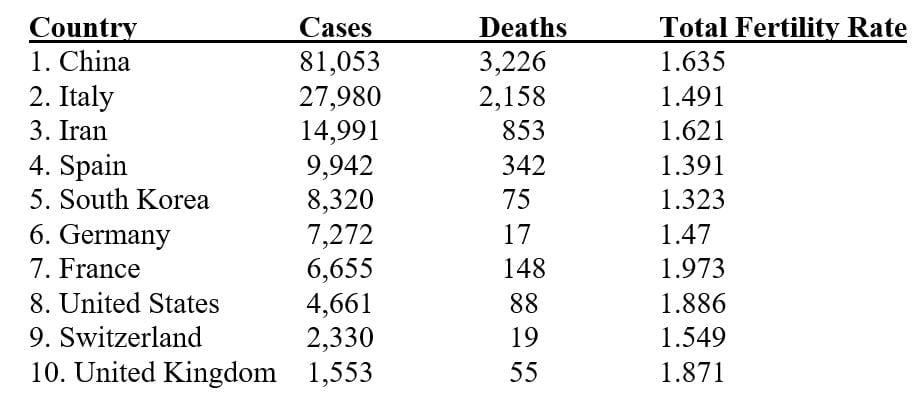ROME – Pope Francis began his daily livestreamed Mass Tuesday morning with a special prayer for the greatest victims of the coronavirus pandemic, and those most at risk as it continues to spread: The elderly.
“I’d like us to pray today for the elderly,” the pope said. “They’re suffering in this moment in a special way, with a very great internal solitude and, at times, with much fear.”
“Let’s pray to the Lord that he be close to our elderly and to all the elderly, giving them strength,” Francis said. “They’ve given us wisdom, life, history, and we too should be close to them in prayer.”
Amid the scramble to find a cure for the coronavirus and, in the meantime, to enforce restrictive measures to try to slow down its expansion, there’s been relatively little attention to the underlying factors which may explain why some places have been harder hit, more quickly, than others.
One emerging hypothesis, however, is that there may be a correlation between declining fertility rates and rapidly rising elderly populations in many societies around the world, and the extent to which those societies have been impacted by the coronavirus.
For the Catholic Church, which has sounded alarms about declining fertility for decades, the situation could offer a grim confirmation of its diagnosis that a rapidly aging society places its future in jeopardy – though no one’s likely to celebrate that it’s required a global pandemic which, to date, has claimed more than 7,000 lives, to put the issue back on the table.
Elderly exposure
By now, it’s become well-established that the elderly are the most at-risk group in terms of death from the COVID-19 coronavirus. A study by the Chinese Center for Disease Control and Prevention found an overall fatality rate of 2.3 percent for the general Chinese population, but it’s 3.6 percent for those 60 to 69, 8 percent for those 70 to 79, and 14.8 percent for those 80 and older.
Chinese data show the median age of a coronavirus fatality is 75, and data from a week ago in Italy put its median age for a death due to the virus at 81.
Though it’s not yet clear if elderly are also disproportionately more likely to acquire the disease in the first place, the American Association of Retired Persons (AARP) reports that research does show the elderly are more susceptible to the respiratory illness, which can cause pneumonia and symptoms such as fever, cough and shortness of breath.
The U.S. Center for Disease Control also reports that in recent years, between 70 percent and 85 percent of seasonal flu deaths have occurred in people age 65 and above.
Comparing the Maps
Demographers say that the Total Fertility Rate needed to maintain a stable population in a society is 2.1 children for each woman who has completed her childbearing years. That’s the number of children it takes for a woman to replace herself with a female who will live to the age of childbearing, taking into account that slightly more boys than girls are born, and that not all children survive.
Among demographers, the shorthand term for that rate of 2.1 is “replacement level.” It’s a striking statistical fact that among the 10 nations hardest hit by the coronavirus to date, not a single one has a total fertility rate above replacement.
Here’s a chart that makes the point, based on coronavirus data from the Johns Hopkins University of Medicine and fertility data provided by the United Nations Population Division.

China’s one-child policy from 1979 to 2015 is the primary explanation for its low fertility rate and mushrooming elderly population. Beginning around mid-century, China is expected to lose 20 to 30 percent of its population every generation, despite returning to a two-child limit four years ago. China is also expected to age as much in one generation as Europe in the last 100 years, prompting the quip that it may be the first Asian nation to get old before it gets rich.
Iran may seem a more surprising case, but it too adopted aggressive family planning policies in 1993 in the wake of the Iran/Iraq war, when the country was dealing with massive unemployment and an increasingly restless youth population. Contraception prevalence in Iran rose from 49 percent in 1989 to 74 percent by 2000, and the total fertility rate dropped from a peak of 6.58 in 1980 to the current level of 1.621.
In light of Iran’s soaring elderly cohort, demographers joke that by 2050, the most popular grassroots organization in the country may not be Hezbollah but the AARP.
At the opposite end of the spectrum, the top 26 countries in the world in terms of the highest total fertility rate are all in Africa, led by Niger with a rate of 7.153 and Somalia at 6.123.
According to the World Health Organization, 27 African nations as of Monday had recorded just 347 coronavirus cases, and some African nations are closing their borders to arrivals from places such as Europe and the United States where the disease is far more prevalent.
Public health experts caution that given the contagious nature of the coronavirus and the highly mobile nature of 21st century societies, sooner or later the virus is certain to arrive in Africa, sparking deep concerns about whether under-developed and already strained health systems may be up to the task.
Still, it remains the case that at least in the early stages of the disease, it was societies with lower fertility rates and rapidly aging populations which suffered the most. As Justin Fox, a columnist for Bloomberg, put it examining the same data: “That’s probably not a coincidence.”
Take-Aways
For the Catholic Church and other advocates of encouraging people to have children, this is undoubtedly not the time to shout “ah-hah” or strike notes that could be construed as triumphal. For one thing, the epidemiological data is incomplete, there’s real concern some countries may be significantly under-reporting their infection rates, testing is uneven, and it’s far too early to draw definitive conclusions from the coronavirus.
On the other hand, there’s a common-sense instinct that says a society with a higher share of younger and basically healthy people probably is in a better position to absorb the shocks of a public health crisis, whereas a society with a disproportionate share of people at higher risk will face greater challenges.
When St. Paul VI sounded an alarm about the spread of artificial birth control and a growing closure to life in his controversial encyclical Humanae Vitae in 1968, the argument was largely couched in moral and spiritual terms. Paul argued that the “unitive” and “procreative” purposes of marriage are intrinsically linked, and it’s a moral mistake to attempt to separate them.
Since that time, however, the risks of overly aggressive efforts to limit population growth also have become apparent on practical grounds. Economists Nicholas Eberstadt and Hans Growth, to take one example, have argued that falling birth rates “portend ominous change in economic prospects, major increases in public debt burdens, and slower economic growth,” largely because they produce a shrinking workforce.
It may be that when the dust settles from the coronavirus pandemic, public health will be added to economics as part of the case for stronger pro-natalist policies such as those adopted by France, which has managed to maintain one of the highest birth rates in the EU in part due to generous social policies, such as subsidized child care, extended paternity leave and tax breaks for larger families.
That won’t have much to do with the Church’s moral arguments, of course, but it may at least mean they’ll get a different sort of hearing.
Follow John Allen on Twitter: @JohnLAllenJr
Crux is dedicated to smart, wired and independent reporting on the Vatican and worldwide Catholic Church. That kind of reporting doesn’t come cheap, and we need your support. You can help Crux by giving a small amount monthly, or with a onetime gift. Please remember, Crux is a for-profit organization, so contributions are not tax-deductible.
















